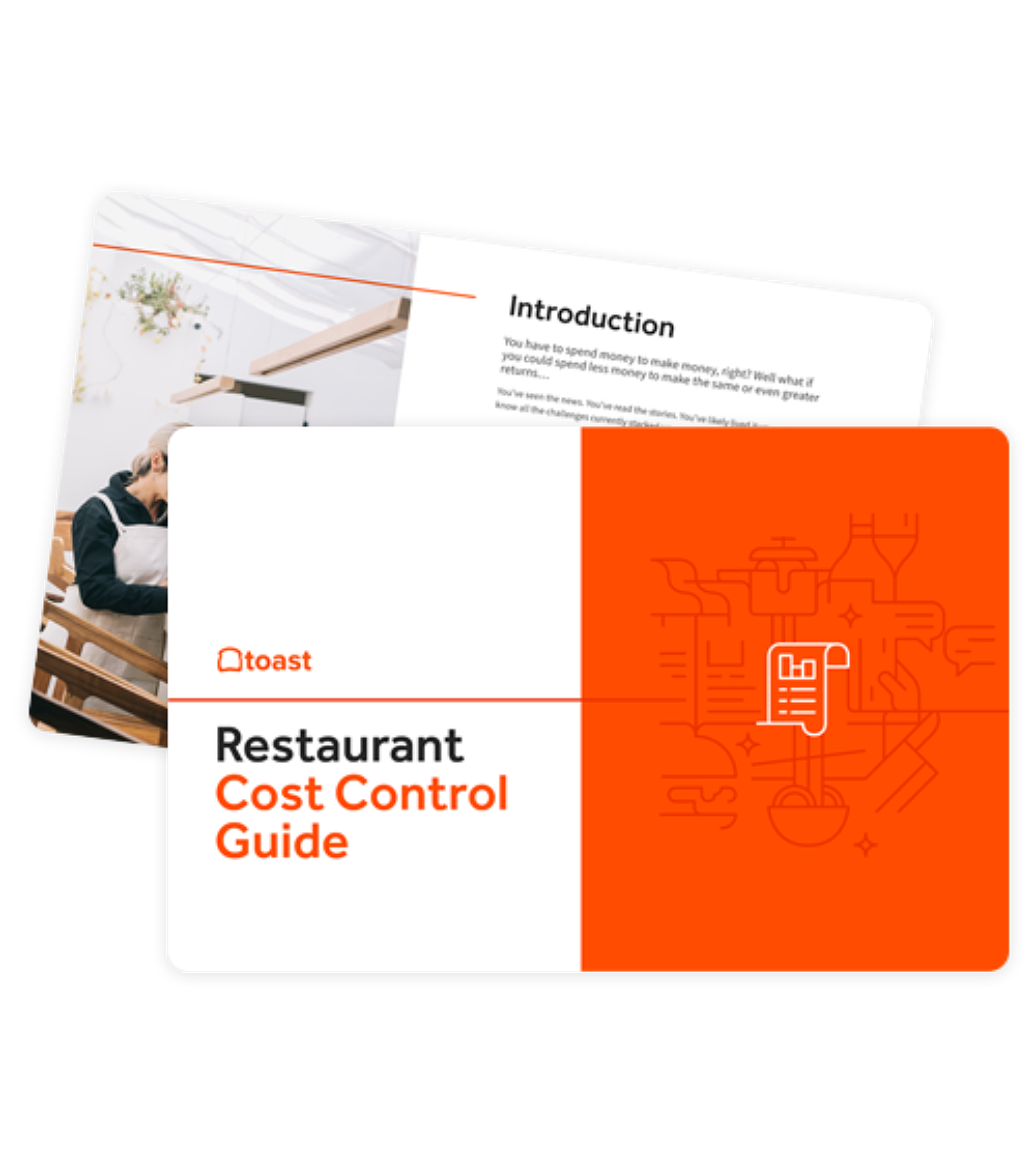
State of Coffee Prices: Wholesale Restaurant Food Cost Trends
See trends and fluctuations for wholesale restaurant coffee prices based on proprietary Toast data.

Justin GuinnAuthor


Restaurant Cost Control Guide
Use this guide to learn more about your restaurant costs, how to track them, and steps you can take to help maximize your profitability.
How important are coffee prices?
Well, coffee consumption keeps the world spinning — with nearly half-a-billion cups consumed every day in America. And of the coffee drinkers that have coffee prepared outside the house, 37% of them are purchasing coffee out at least four times a week.
Given these stats, it’s easy to see how important the wholesale price of coffee may actually be for helping keep the world turning.
Restaurant Operator Insights Report
See insights from real restaurant operators which can help you benchmark your current and planned restaurant technology stack against your peers as we head into 2024 and beyond.

Toast is the restaurant point of sale system built for restaurants.
We're able to calculate the average monthly prices that coffee shops, cafes, and other restaurants pay for coffee by using proprietary data from xtraCHEF by Toast, our invoice automation and recipe costing tool.
The average national price restaurants paid for a pound of coffee beans is $10.92 in July.
On average, a pound of coffee beans typically brews around 30 cups of coffee (12oz cups based on the Speciality Coffee Association’s recommended 1:18 brewing ratio of coffee to water [55g coffee to 1kg water.])
Interestingly, the average national price restaurants paid for a pound of coffee grounds is $4.70 in July —so that’s a 132% coffee price increase from grounds to beans.
Here's a breakdown of historical data on wholesale restaurant coffee bean prices over the last year:
Restaurant coffee bean prices topped off at $11.63 per pound on average in March 2023. Ground coffee prices peaked at $6.41 at the start of 2023 — rising sharply from December and falling sharply in February.
Here's a breakdown of recent month-over-month fluctuation in wholesale restaurant coffee prices for beans and grounds:
Wholesale coffee bean prices are down 6% month-over-month — though they’ve been relatively flat MoM for the past 12 months with an average fluctuation up or down at 2.6%.
Ground coffee prices are anything but flat. They’ve fallen 24% MoM and have been highly volatile over the past year — fluctuating from a low of $4.50//lb to a high of $6.41/lb.
Commodities experts weigh in on coffee prices
We were able to speak with some experts in the food commodities space to understand their analysis on coffee price trends and the impacts on restaurants.
Question
From a coffee shop/cafe perspective, how can you explain the avg price differences between coffee beans and grounds — as well as the extreme volatility in grounds compared to beans? And why would restaurants go with whole beans over pre-ground (assuming coffee quality + control here)?
Coffee shops focus on coffee-to-order and specialty drinks. For premium quality, coffee shops procure roasted arabica beans to meet their desired flavor profiles. This specialty usually commands a premium as specialty beans from different growing regions around the world have different flavor profiles. Based on the type of coffee needed, coffee shops will seek high quality beans meeting the exact roasting and flavor standards needed to meet their consumer demand. This is a lengthier process and more specialized process versus producing ground coffee in bulk. Thus, beans will cost more as the requirements to produce specific flavors is a special production. Ground coffee tends to blend Arabica and Robusta coffee beans. Robusta coffee is a cheaper bean than arabica and has a different flavor profile. Additionally, ground coffee for restaurants is not always a specialty blend so beans do not need to meet specialty flavor standards. When a processor can provide large quantities of ground coffee using cheaper beans without customization to a flavor profile, they can deliver that product at a cheaper price to their customers. Thus, ground coffee is typically cheaper to produce and procure. Coffee maximizes its flavor with a fresh grind. Once ground, it will start to lose its flavor over time. Therefore, most specialty coffee is ground-to-order and brewed in a method designed to maximize flavor. This is why barista brewing stations (making espresso) are expensive machines.

Brad Rubin
Wells Fargo Agri-Food Institute
Grinding your own coffee beans vs buying coffee ground
As a cafe, coffee shop, or restaurant operator, you may need to decide whether to grind your own coffee beans or buy coffee that is already ground. There are advantages and disadvantages to both options that you should consider.
Grinding your own coffee beans allows you to have complete control over the freshness and quality of your coffee. When you grind your own beans, the flavor and aroma of the coffee are at their peak. This is because coffee beans start to lose their freshness and flavor once they are ground due to increased exposure to air. By grinding your own beans, you can ensure that each cup of coffee you serve is made with the freshest coffee possible.
On the other hand, buying pre-ground coffee can be more convenient and time-saving. It can eliminate the need for investing in a coffee grinder and spending time grinding beans. Pre-ground coffee is also more consistent in terms of grind size, ensuring a more uniform extraction. However, it is important to note that pre-ground coffee has a shorter shelf life and may not deliver the same level of freshness as freshly ground coffee.
Ultimately, the decision between grinding your own coffee beans and buying pre-ground coffee depends on your priorities and guest preferences. If guests value freshness and the ability to customize each cup of coffee, investing in a grinder and grinding your own beans is the way to go. However, if convenience, consistency, and price point are more important for guests, buying pre-ground coffee may be a better option for your business.
Defining key coffee terms: Robusta, Arabica coffee, and more
As a cafe, coffee shop, or restaurant operator, it is essential to have a good understanding of key coffee terms to make informed decisions about your coffee offerings.
Two common coffee terms restaurant operators should be familiar with are Robusta and Arabica.
Robusta and Arabica are the two main species of coffee bean that are commercially grown and consumed globally.
Arabica coffee is considered to be of higher quality and arabica beans can be known for their complex flavors, acidity, and aroma. It is generally more expensive than Robusta and accounts for a significant portion of specialty coffee production.
Robusta coffee is known for its high caffeine content and stronger, more bitter flavor profile. It is often used in commercial blends and instant coffee due to its lower cost and higher yields. Robusta plants are hardier and more disease-resistant than Arabica plants, making them easier to cultivate in different climates.
Other important coffee terms to know include "single origin" and "blend."
Single origin refers to coffee that comes from a specific region or farm, offering unique flavor characteristics and showcasing the influence of terroir. Blends, on the other hand, are a combination of coffee beans from different origins to create a particular flavor profile or consistency.
Green coffee refers to raw coffee beans that have been harvested, processed, and dried but not yet roasted. It is in this unroasted form that coffee beans are traded and exported around the world. Green coffee is a vital component of the coffee supply chain, as it is at this stage that coffee beans start their journey to becoming a flavorful cup of coffee.
Latte is a popular espresso-based coffee beverage that consists of espresso shots mixed with steamed milk. It is often topped with a thin layer of foamed milk. Latte is beloved for its smoothness and creamy texture, making it a staple in many cafes and coffee shops.
Espresso is a concentrated coffee beverage made by using high pressure to force hot water through finely ground coffee. It is the base for many popular coffee drinks, such as cappuccinos, lattes, and macchiatos. Espresso is known for its intense flavor profile and rich, velvety crema on top.
Ice coffee is a refreshing coffee drink that is served chilled or over ice. It can be made using various brewing methods, such as cold brew or iced espresso shots. With its popularity on hot summer days, ice coffee is a must-have option on many cafe menus.
European, New York, and China are terms associated with different coffee cultures and preferences. European coffee often refers to the strong, dark-roasted coffee commonly enjoyed in European countries like Italy and France. New York coffee culture, on the other hand, is known for its diverse range of specialty coffee shops and innovative brewing methods. China represents a burgeoning coffee market, with a growing number of coffee shops and increasing consumption of coffee among Chinese consumers.
Restaurant Operator Insights Report
See insights from real restaurant operators which can help you benchmark your current and planned restaurant technology stack against your peers as we head into 2024 and beyond.

Coffee Production and the state of the coffee supply chain
The coffee supply chain is a complex process that involves multiple stages, from cultivation to consumption. Understanding the state of the coffee supply chain is crucial for cafe, coffee shop, and restaurant operators as it directly affects wholesale coffee prices and availability.
Coffee production starts with the cultivation of coffee plants, mainly in countries located in tropical regions. The two main coffee-producing regions are Latin America and Africa, with Brazil, Colombia, and Ethiopia being the largest producers and coffee exporters. Coffee cherries are hand-picked, processed, and then the beans are separated from the fruit. After processing, the beans are typically exported, roasted, and finally distributed to retailers.
The coffee supply chain faces various challenges, including climate change, diseases, and market volatility. Climate change poses a significant threat to coffee production, as rising temperatures and extreme weather events can impact crop yields and quality. Diseases, such as coffee leaf rust, can devastate coffee farms, leading to decreased coffee supply and increased prices.
Additionally, market volatility can greatly affect wholesale coffee prices. Factors such as global demand, currency exchange rates, and speculation can create price fluctuations in the coffee market. Cafe, coffee shop, and restaurant operators need to closely monitor these trends to ensure they can anticipate and manage any potential impact on their business.
To ensure the sustainability and quality of the coffee supply chain, many organizations and certifications have been established. Fair trade certifications, for example, aim to provide fair wages and working conditions for coffee producers, promoting social and environmental sustainability.
By staying informed about the state of the coffee supply chain, cafe, coffee shop, and restaurant operators can make strategic decisions about sourcing, pricing, and menu offerings. This knowledge will not only help in delivering quality coffee to customers but also support the sustainability and resilience of the coffee industry as a whole.
Start tracking coffee prices today
Coffee is a hugely popular beverage that can offer some real profitability padding for restaurants. Incorporating coffee prices — and all ingredient costs — into financial reports requires restaurant operators to have a strong back-of-house foundation built on invoice automation.
Invoices are the single source of truth for restaurant costs — pinpointing prices and fluctuations for individual ingredients as well as paper goods, non-alcoholic beverages, and more.
With accurate and up-to-date ingredient prices from invoices, operators can start calculating plate costs. Plate costing is a detailed exercise that zooms into the recipes and/or individual ingredients that make up a dish — requiring detailed recipe costs and portion costs for ingredients.
Costing exercises can help show how each component is contributing to the overall profitability of a dish or drink. And recipe costing software can help make it easier to calculate and achieve an ideal balance between portions and profits.
Methodology
Toast analyzed monthly invoice items for coffee beans and grounds from restaurants using xtraCHEF by Toast. Items are weighted by the frequency of orders, not quantity. A standard unit of measure is determined so that an average price can be calculated across all invoice inclusions of the ingredient.
Is this article helpful?
DISCLAIMER: This information is provided for general informational purposes only, and publication does not constitute an endorsement. Toast does not warrant the accuracy or completeness of any information, text, graphics, links, or other items contained within this content. Toast does not guarantee you will achieve any specific results if you follow any advice herein. It may be advisable for you to consult with a professional such as a lawyer, accountant, or business advisor for advice specific to your situation.
Subscribe to On the Line
Sign up to get industry intel, advice, tools, and honest takes from real people tackling their restaurants’ greatest challenges.
